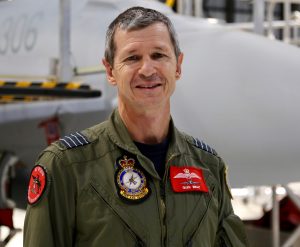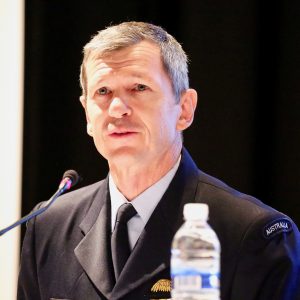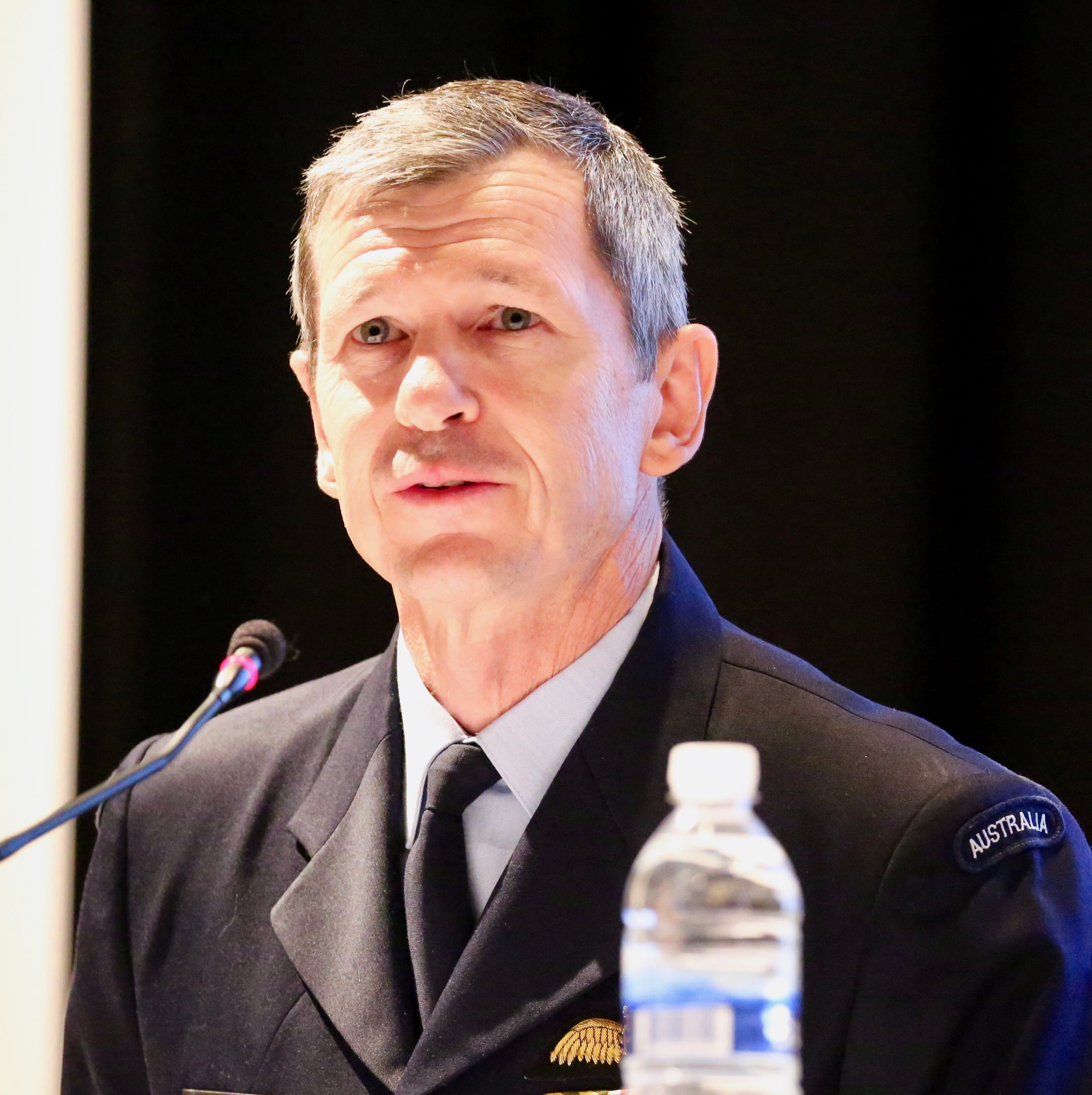2017-08-28 By Robbin Laird
On August 23, 2017, the Williams Foundation held a seminar on the future of electronic warfare.
At the heart of the Seminar and the discussion were the presentations by Group Captain Braz of the RAAF, a key figure in the introduction of the Growler into the RAAF, and CDR Mike Paul, Electronic Attack Wing, US Navy Pacific Fleet.
The two provided a significant look inside the standing up of the RAAF capability and the key role of the US Navy in this effort, and in turn the ability to standup up a joint capability.
The US Navy has provided an important lead in working the relationship with the RAAF in standing up this capability and in a rapid manner. In many ways, the Growler dynamic between the two forces provides a model of how capabilities can be generated rapidly in a coalition context to deal with an evolving threat environment.
For the RAAF, Growler represents a jump start to a 21st century EW effort, which includes Wedgetail and F-35. For the US Navy the cutting edge work which the RAAF is doing with regard to shaping a 21st century integrated force helps the US Navy to think through ways to break through stove piped thinking.
In this article, I will look at Group Captain Braz’s presentation with regard to the RAAF approach.
I had a chance to meet with him last Spring at Amberley Airbase where the RAAF is standing up the Growler capability.
So for me, it was a real pleasure to see him again, but this time, in the context of a broader discussion of evolving capability with other core players in the effort as well.
 Group Captain Glen Braz, OC of the 82nd Wing.
Group Captain Glen Braz, OC of the 82nd Wing.
The nature of the working relationship between the US Navy and the RAAF was highlighted during that interview as follows:
We couldn’t have done this without a huge commitment from the U.S. Navy. There’s simply no other way to describe that.
They have wanted us to be on this journey, and they have supported us wholeheartedly throughout it, both on what we do with the Growler training and the operational experience, the exchanges we’ve established, and how we prepare the team.
That’s furthered by exchange opportunities. We have U.S. Navy Growler aircrew joining us here, but we’ve also used folks connected to intelligence organizations and data management organizations and used U.S. Navy expertise in those areas to bring us along and further on the journey.
It’s no accident that when the Growler officially arrived in Australia at Avalon International Air Show a month or so ago, one of the four humans to step out of those two aircraft was a U.S. Navy aviator.
That was very deliberate, because we wanted both to recognize the amazing support we have had so far from the US Navy and the fact that we’re in this together.
It’s a partnership for the long term with cross learning on all sides.
Captain Braz noted that the Aussie Growlers were on track for IOC next year and that “6SQN took part in Talisman Sabre, and they are busy baselining their operations to align with wider Air Combat Group and 82Wing standards.”
He underscored that the RAAF was focused on taking EW from a niche capability within the ADF to working into a core competence within the integrated force.
“How we might drive this jet, and wider EW and cyber thinking, into the mainstream?
“Please note my use of the word drive. We need to take this thing and forcefully insert it into our daily business.
“To let it drift or meander into some equilibrium would be a lost opportunity.
“It’s time to be bold.
“The arrival of F-35 in the next year or so is one prime opportunity, and one that will need bold leadership to harness.
“The F-35 brings unprecedented EW capability, it can fight like no other fighter we have owned.
“Growler is an exceptional complementary capability and crossing personnel over between the teams will bring amazing results.
 Group Captain Braz at the Williams Foundation Seminar on Electronic Warfare, August 23, 2017
Group Captain Braz at the Williams Foundation Seminar on Electronic Warfare, August 23, 2017
“A good friend of mine from the US Navy planted this idea in my mind some months ago and it has significant merit.
“Setting up a Growler to F-35 exchange program won’t be easy, it won’t fit well into a transition plan and it will challenge some outdated mindsets, but it will be a brave move that will put innovation into overdrive.
“It’s an example of the new thinking we need to reshape the way we fight air combat.”
Group Captain Graz then dealt in the rest of his presentation on the challenges as he saw them in managing the way ahead.
First, there is the challenge of managing growth.
Growler is a low density, high demand asset. Shaping and managing a workforce and ensuring its integrated beyond the platform is a significant challenge.
Second, Growler will operate under significant constraints in spectrum licensing and security.
Third, “Growler is part of the overall rethinking necessary with regard to targeting or rethinking with regard to payloads for the RAAF operating as part of an integrated 21st century combat force.
“Growler is a flexible system, manned by expert crew.
“It takes the initiative whenever possible but is by design a flexible sense and respond asset that is at its best when given significant latitude in targeting.
“Being overly tied to our kinetic and lethal effects targeting mindsets will not give you the Growler you need on the day.
“New thinking in terms of dynamic targeting, particularly of non-lethal effects, many of which may be temporary in nature, will be a key to success.
“Delegating these engagement authorities forward will be essential.”
Fourth, training to ensure that EW becomes part of the force, rather than a stove piped on call capability is a major challenge.
“We have invested heavily in training and rightly so; we are not there yet but the future is positive.
“Importantly, the rapidly evolving Electronic Warfare capabilities across the ADF need new ways of thinking to get the most from our family of systems.
US Growler Operating at RAAF Base Amberley from SldInfo.com on Vimeo.
“New training areas that test our ability to find, fix, track, target and engage adaptive threats are fundamental to our force.
“Of course, with the constraints already mentioned, live virtual and constructive environments are being enhanced and expanded to serve our needs.
“Ultimately fifth generation forces need fifth generation training.”
Fifth, the Group Captain emphasized the importance of what he called commonality both across the ADF and the allied forces using Growler.
“We have made changes to these jets (RAAF Growerls) based on Australian needs but they have changed the US Navy common baseline.
“Careful investment has given our Growlers targeting pods and Infra-red missiles.
“Not because it’s a fighter but because they help our active and passive kill chains.
“The US Navy is joining this path; it’s a team effort and our differences bring useful diversity to shape the growth of this aircraft.”
And the final challenge he addressed really flowed from how he saw the introduction of Growler as part of the broader evolution of the RAAF to support a payload revolution.
“Our thinking needs to cover payloads not just platforms and be driven by creative technical thinkers, connected with operators.”
Group Captain Braz ended on a very forceful note – don’t built a community of Growler operators; build a joint force within which EW is a core distributed competence.
“Our true challenge, as swimmers in the mainstream, is to acknowledge the currently niche players in EW, assist their real and important growth and to drag them into our swim lane; to roll their input and concepts into every plan, to seek to understand more and engage better.
“Our new thinking must be beyond labels like EW operators but that this expertise permeates our business as an assumed skill.
“So, as a strike fighter native, I am happy to wear an EW tag but I want it to be a temporary one.
“The day where we are all suitably learned in EW that it no longer becomes a label is what we should strive for.
“That would signify success.
“That would have seen the mainstream embrace EW and cyber.
“So, my challenge to you is, regardless of your organisation, are you an operator in our age of EW?”


